I admit it. I love this musical instrument. A little known woodwind from Eastern Europe, the tárogató is something of a cross between a saxophone and a clarinet. It is made of wood, and has the keys and finger holes of an old Albert system clarinet. But the bore is conical, closely resembling that of the sax. The sound is something like that of the soprano sax, but with touches of Cor Anglais and oboe.
I bought my first tárogató from eBay, and it was a gamble gone wrong. It turned out to a modern Romanian instrument, cheaply made, poorly maintained, unplayable. None of this was evident from the pictures. Luckily it found a new life with a friend who is an instrument repairer, and who made its restoration a major project.
I realized that my mistake had been in knowing nothing before I plunged in. I started to research this instrument, and soon realized that information on it was scarce. I found that the instrument has been invented at the end of the 19th century by a man named V.J. Schunda. Legend has it that he was offended by the new “saxophone”, for its large tone holes, many keys and metal body. He decided to “reform” a traditional instrument from the region, the tárogató. He took this original — something like a keyless oboe — and added a clarinet-type single-reed mouthpiece instead of a double-reed, enlarged the bore and added a simple system of keys modeled on the Albert clarinet.
Actually though, the origin of this “reform tárogató” is still in dispute. Another instrument maker named János Stowasser had submitted a patent almost identical to Schunda’s at exactly the same time. Nobody knows who said what to whom, but Schunda is generally given the credit for developing the tárogató, and his fathering of the other national instrument of Hungary, the cimbalon, is not in dispute.
Stowasser went on to become the most respected maker of tárogatók, introducing a number of innovations. He produced many instruments between 1897 and 1917, when the factory burned down. Schunda produced far fewer instruments, and while original Stowassers are in circulation and come up for sale with regularity, it is very difficult to find a Schunda anywhere, much less one in decent condition.
After WW II, many cheap copies of the classic 19865 model by Stowasser were produced in Romania, such as the one I unknowingly bought in my first venture into this world. Recently there has been a revival in interest in the tárogató, and it is beginning to see use in western jazz, played by notables such as Joe Lovano, Peter Brotzmann and Dino Soldo. A number of manufacturers of good tarogatok (plural of ‘tarogato’) have sprung up, both in Hungary and abroad.
My second instrument was a Remenyi. A quite nice older instrument made of beautiful grenadilla with a bell of palisander wood. This was what is called a “two ring” model, in which only two of the six fingers have ring keys operating auxillary keys. It has only a single octave key as well, making the playing of the topmost notes quite a challenge. As I became more proficient, I began to long for a Stowasser, the “Stradivarius” of tárogatók.
Before too long, I found one for sale. Luckily the seller was himself a stellar player, and the owner of the largest collection of tárogatók in the world. I felt I could trust him, and indeed the instrument turned out to be all I had imagined. Nice as the Remenyi was, it could not equal the Stowasser for ease of playability and good intonation. But all tárogatók are unique and have their quirks, and the Stowasser was no exception. I spent some hours “tuning” the instrument by reducing the diameter of several of the tone holes with tuning crescents, since those notes were sharp. But soon I had an instrument that played beautifully from bottom to top.
With the Stowasser I had the instrument that I thought I would live with and die with. But still I checked eBay and other sources, just to see what kind of instruments came up for sale. Many manufacturers, both small and large, made instruments in the first part of the 20th century and these often were unique and interesting.
…The Schunda….
One day, for no good reason, I decided to check some of the eBay international sites after seeing nothing of interest on the main US site. Something caught my eye on English eBay. A tárogató by V.J. Schunda? I doubted this. The world of tárogató — long before Chinese fakes — was full of counterfeit instruments: fake Stowassers and counterfeit Schundas were waiting to trap the unwary. Fake Stowassers are easy to spot if one knows what the real ones look like, but what did a real Schunda look like?
Luckily the pictures accompanying the auction were clear. This was definitely a high-quality instrument, but was it a Schunda? I began to troll the Internet and Google images for pictures and descriptions of Schunda instruments and what I found was scarce indeed.
The best site in my experience for researching tárogató is that of Henk Jansen, who maintains a detailed site at 11th Muse.
I had pored over it avidly in my early days of tárogató research. Henk had a couple of pictures of unmarked instruments presumed to be Schundas, but without a maker’s mark. The one I was thinking to bid on had maker’s marks, and that was the first thing I wanted to see. I now turned to Google images, and I got my first break. There was a Schunda tárogató in the Horniman collection in the UK. The maker’s mark matched! But there were notable differences in the design. The pictures were not good, but I did my best to compare the instruments. The Horniman instrument appeared to have been made for an exhibition, with simpler keys and a black lacquered body, but the general design matched. I wanted more confirmation. But time was running out, the auction was ending.
The price was still very low, about 500 GBP. I decided to bid 800. I would not go above that, I kept telling myself, I had a great Stowasser, and I was still not convinced that this was real. The auction was ending at 4 am my time. I woke up to see what was happening. Five minutes before the end of the auction I was outbid.
What to do? Did I really want to risk it, like I had on the first tárogató? Did I need this? No, but I wanted it. I upped the bid to 1000 GBP. With one minute to go, I was outbid again. “That’s it,” I thought. “I’m outta here.” I navigated away from the page to go do something else. But I had to have a last look. At 30 seconds, the price was still just 1050 pounds. This is cheap for a good ttárogató!
I bid 1200 GBP. FINAL bid.
With 15 seconds to go, it jumped to 1170 pounds. I expected it to jump to 1210. It didn’t. Suddenly the auction was over. I had won.
Then the anxiety hit. What had I just done? Another tarogato? I have two! What if it is completely messed up? It wouldn’t be the first time…
I didn’t sleep so well. But I was committed, and I would hope for the best.
Now I really wanted to know if this was real. Back to the Internet, even deeper.
I managed to find another Schunda instrument in the Nicholas Shackleton collection, and again, the keywork was simpler, made of different wood, but again the maker’s mark matched, and there were major similarities in the design of the keys. I began to be more confident.
I eventually found pictures of several other Schunda instruments, one even having the same general keywork as the one I had bought, in the famous musical instrument museum in Brussels. Now I was pretty sure that this was a genuine. But many of these — especially the few I found for sale — were heavily worn, whereas mine appeared to be in very good shape. How could that be?
I wrote to the seller to see if she knew anything about its provenance. She told me that she had found it in a small antique shop in Copenhagen, now closed. Copenhagen? What was a tárogató doing in Denmark of all places?
But that might well have explained it. Some Dane bought this instrument around 1910 and brought it back home with him. He played it rarely, and it probably ended up in a closet or attic for the better part of a century. Schundas and Stowassers in Hungary or Romania, by contrast, were played and played, and then passed on to a new generation of players. And it was just lucky for me that this one had not been offered for sale on eBay USA, where it would have been seen by many more people.
And now the odyssey is nearly done…
The instrument arrived and it is even nicer than I had dared to hope. It has some features that were not common to Schundas, and I believe that it was a very expensive model. The quality of the wood, and the metal rollers on the pinky keys point to that. Even the Stowasser instruments have plastic rollers.
I have had it apart and cleaned it up, oiled it and adjusted it a little. It could use new pads, but it plays top to bottom, and it plays very well. I couldn’t be happier. Let me share some pictures and comments with you:
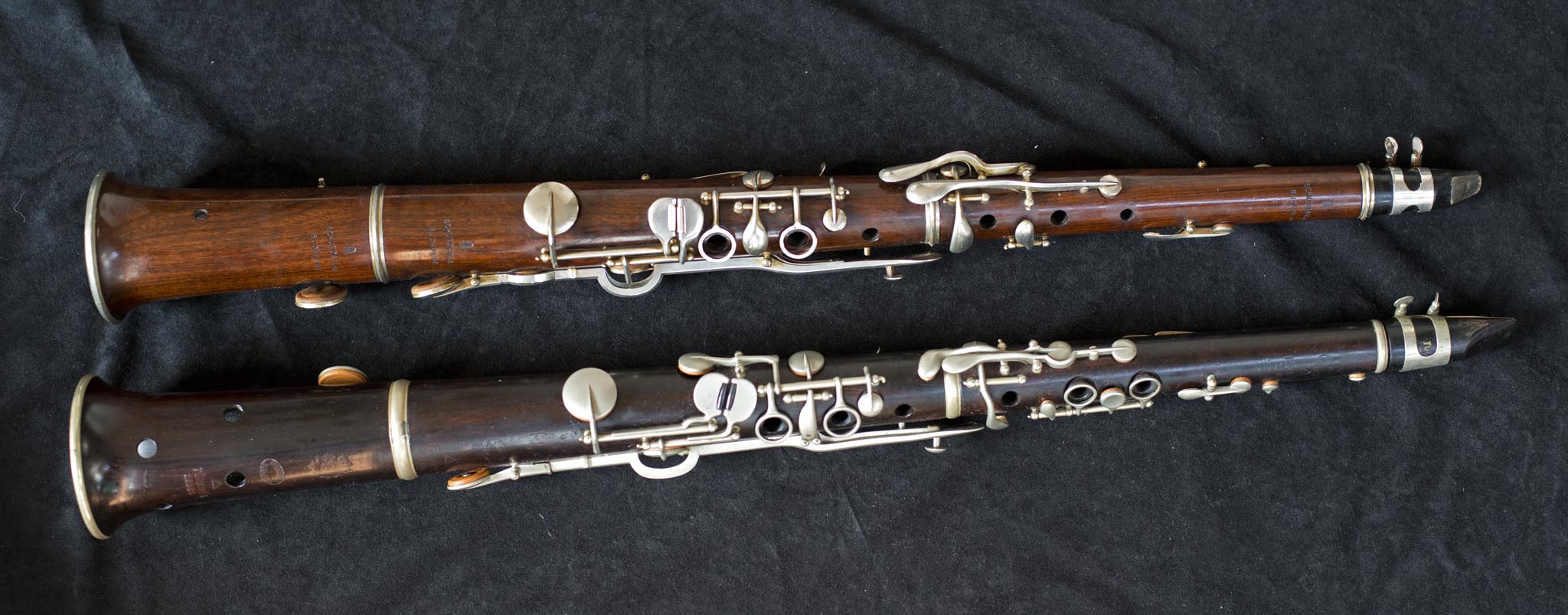
Full image. The Schunda is above, the Stowasser below

Here is the maker’s mark: name and place, topped by a coat of arms
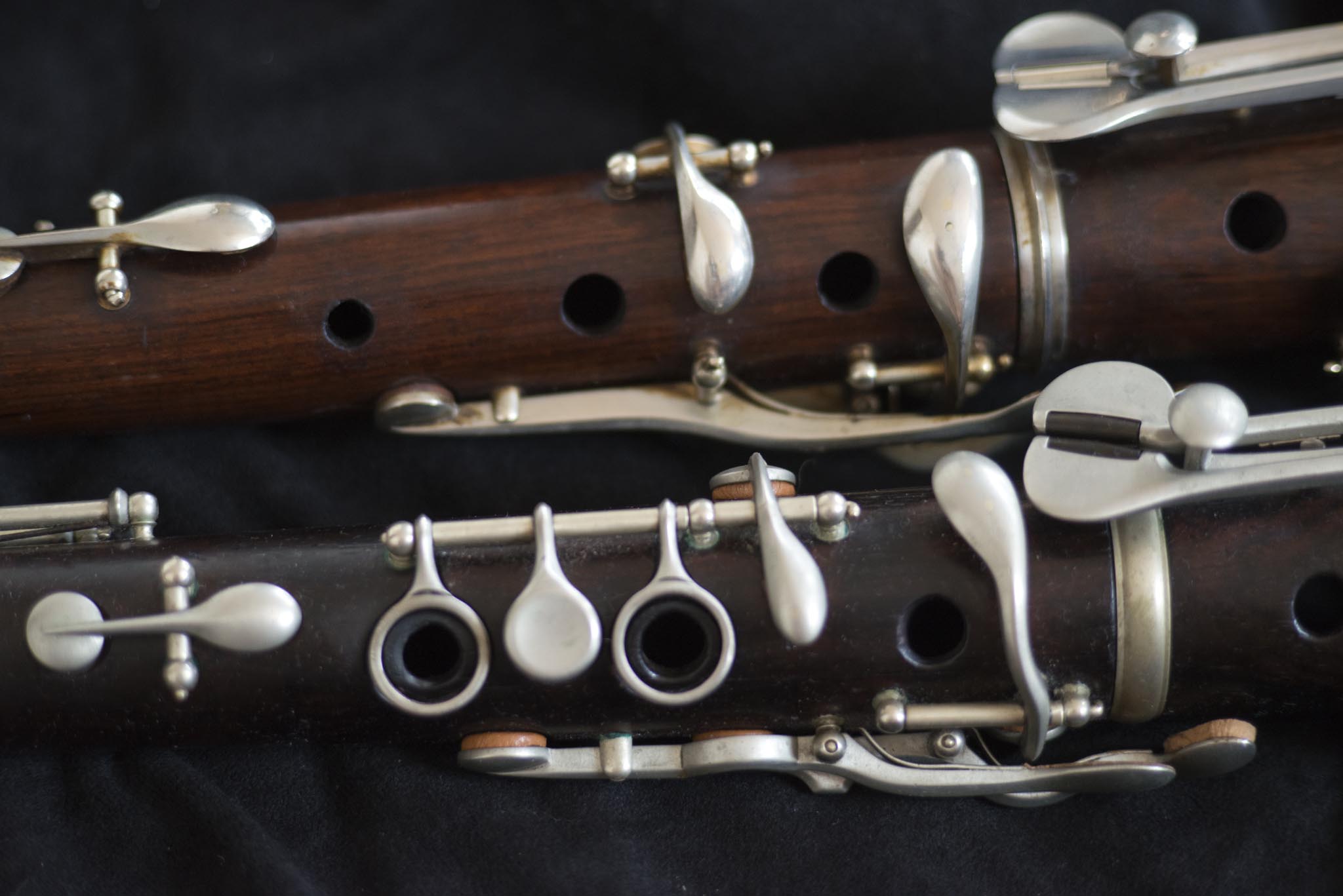
The Schunda is a two-ring model, and the Stowasser four-ring. On both instruments there are two rings on the lower body joint. The two-ring design was Schunda’s original, and as far as I can tell, he never made a four-ring instrument. Note the “bulbous” front Bb and G# keys. This was one of three characteristics unique to Schunda instruments that clued me in that this was real, as it is found on all the later Schunda instruments that I saw.
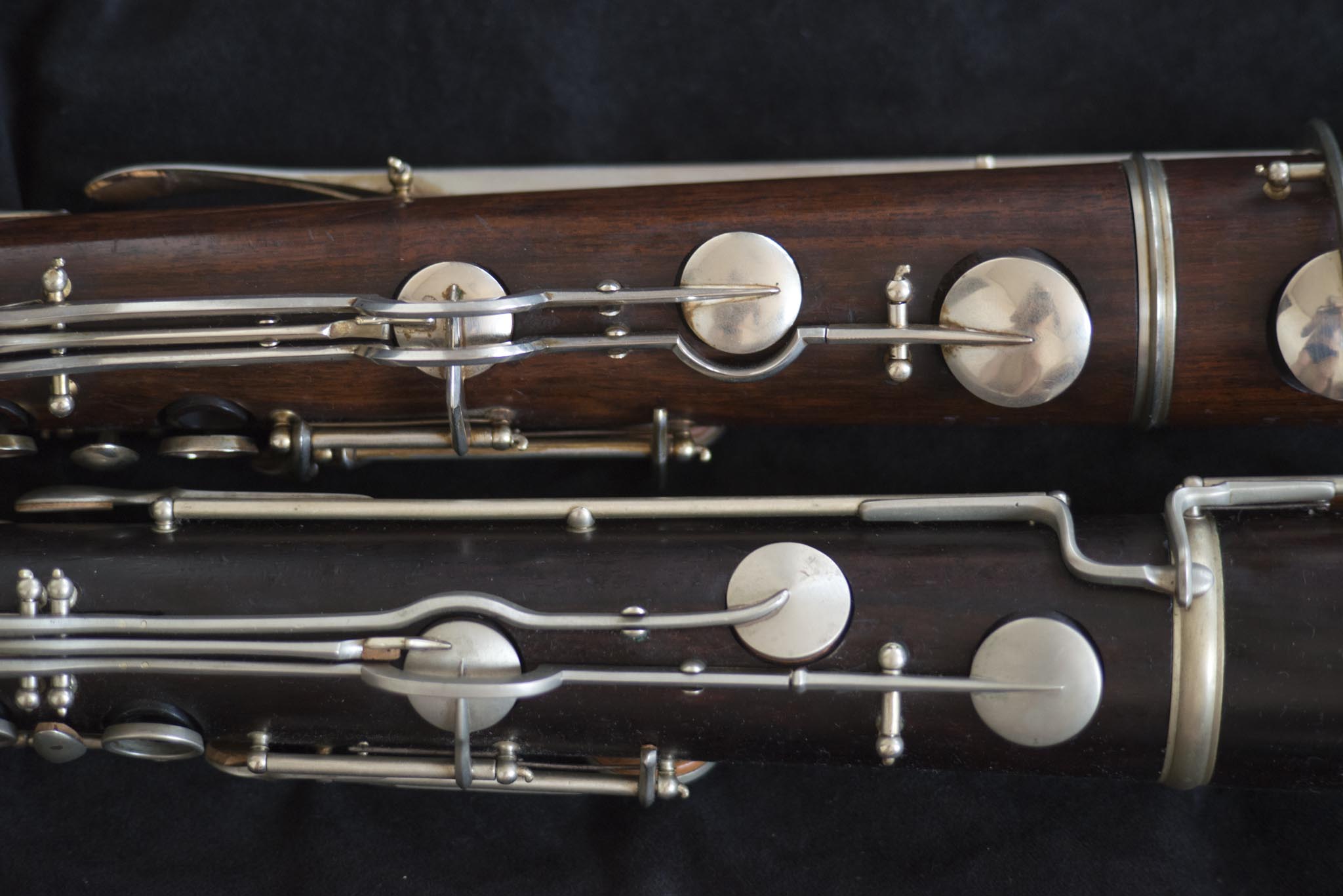
Here was another major clue: the design of the lower key arms. Note that the Schunda has both B and C# arms arching over the Eb key. They are set close in line, with the B arm arcing around the C# key cup. This was also a common characteristic on the Schundas I saw, and not the same on any other make of tárogató. The Stowasser arcs the C# arm around the Eb cup, and offsets the C# key cup.
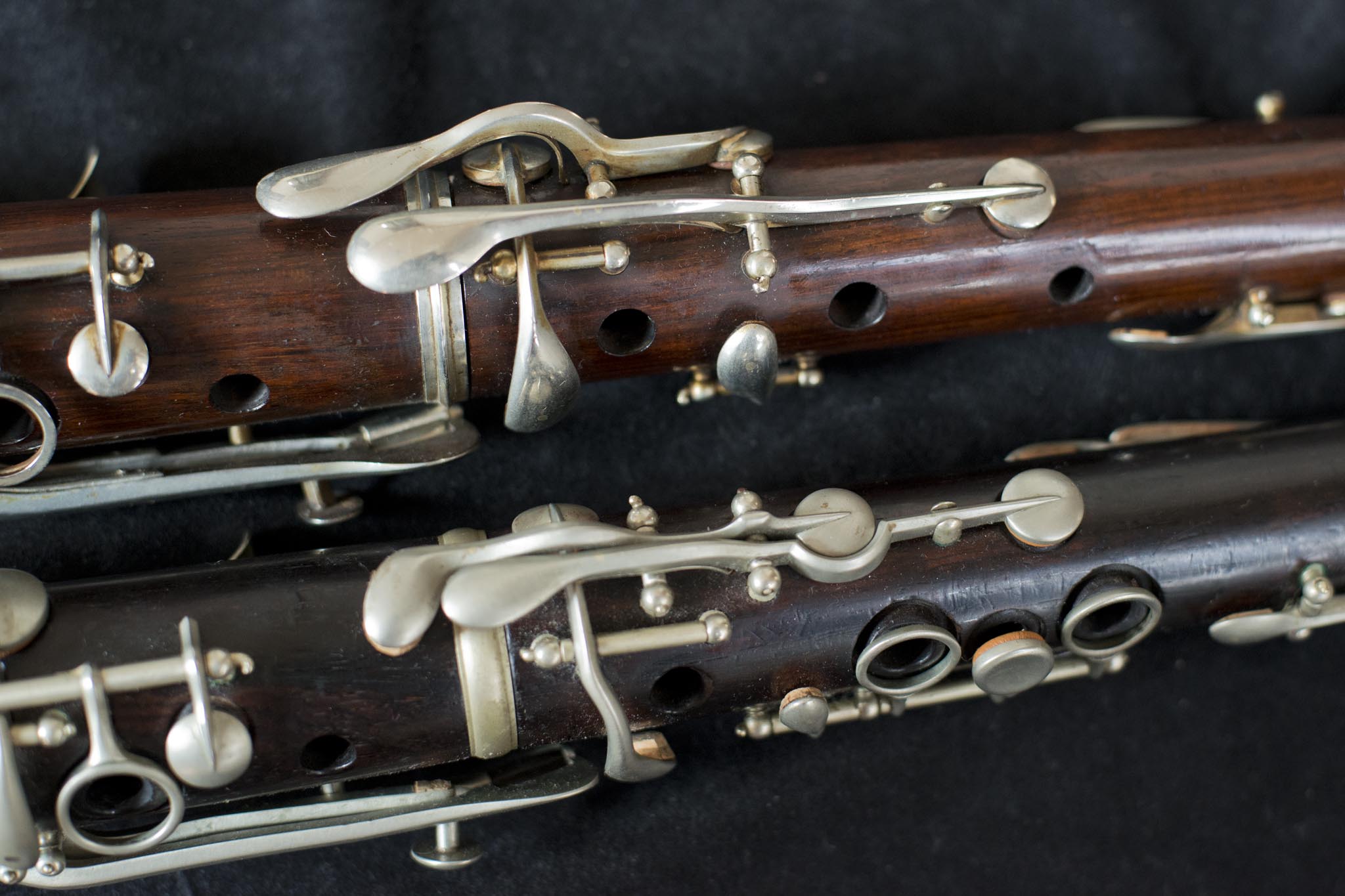
Here is the third telltale: the design of the side keys. On almost all tárogatók, the two keys are set close together, as on the Stowasser. Schunda (and only Schunda) sets the two keys apart. Actually, I find the Schunda design superior for ease of playing.
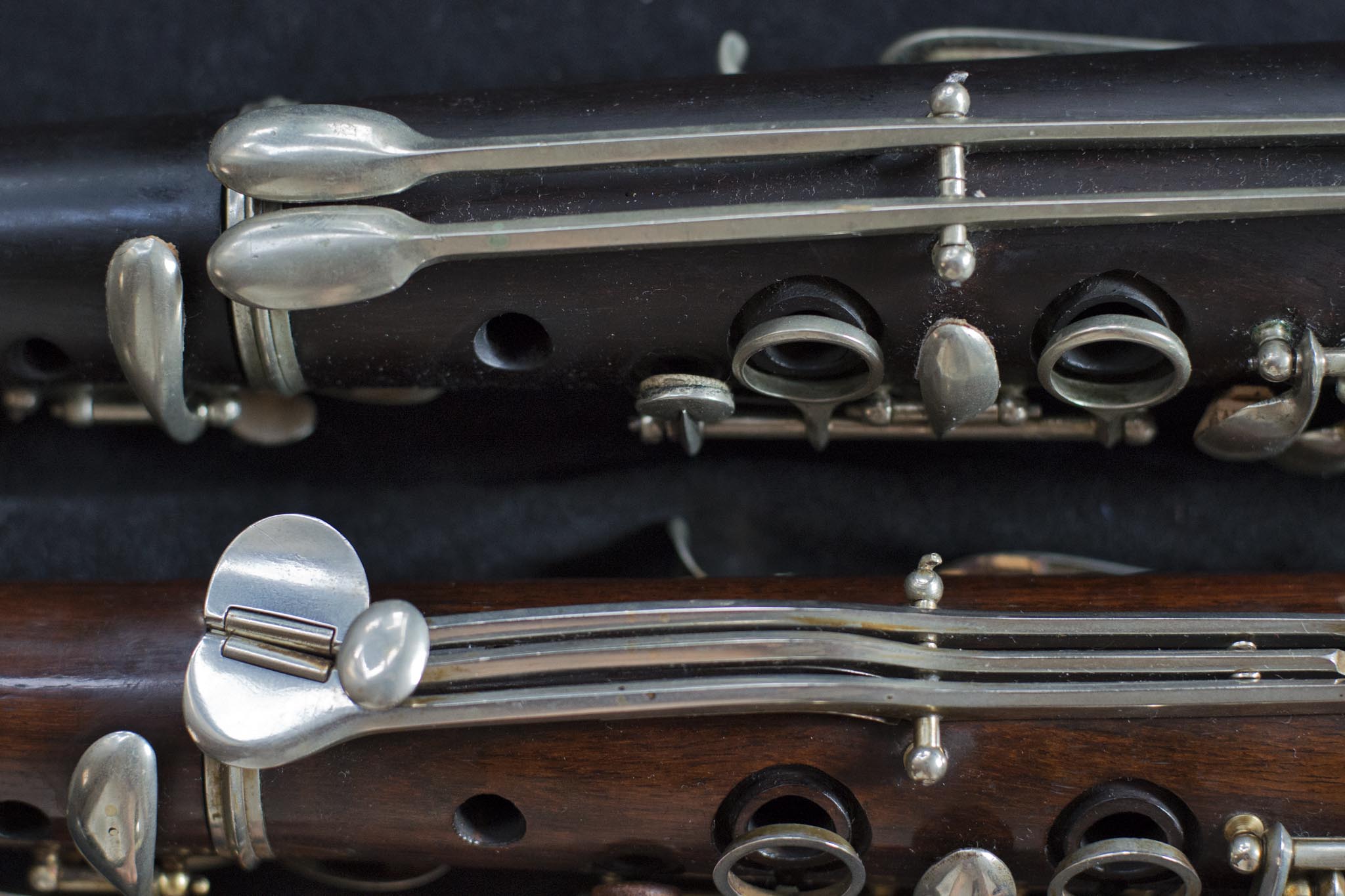
This threw me: the top design, a pair of rounded key touches (on my Remenyi), was the normal Schunda design, and was used on early Stowassers. At some point Stowasser went to flat key touches with rollers, as seen on the Schunda. But while I could find Schundas with rollers on rounded keys, I never saw any Schunda with these flat keys. These keys, along with the metal rollers, makes me think that this was either a special order or an expensive model, and definitely a later rather than earlier instrument. It is also unusual to find a Schunda with the middle key–an alternate Eb key, though these are fairly common on Stowassers. I did finally find another Schunda with the Eb key, but the angle of the picture does not let me see the shape of the B and C# key touches on that instrument.

The Remenyi on the right has the traditional right pinky key touches, again rounded like those on an oboe. Here again this Schunda surprised me. Early Schundas have the rounded touches, whereas the later ones had semi-rounded touches with plastic rollers. I finally did find one instrument, as mentioned above with the alt Eb, that had similar touches, but on that one the rollers were black plastic.
Here are the same keys on the Stowasser, below. One interesting thing to note is the difference of the soldering of the key arms to the axles. Schunda solders them straight on perpendicularly, where Stowasser curves them and solders them along the axle.
Another unique feature of this Schunda is the double octave key. All that I have seen (but I have not seen the back of the one that shared characteristics as described above) have single octave keys. In this Schunda seems to have been a traditionalist, even though the double key allowed the top of the second octave to be played, something possible only with special fingerings on the single key models. But this instrument has a double octave key. Interestingly, the bore design of the Schunda makes it very difficult to reach above second octave G, so the double octave key here seems to be designed to keep the first part of the second octave in tune. Second octave D is traditionally a very bad note on the tárogató, and by using the lower of the two keys here, it sounds perfectly, as does E, with F and G playing best using the second key. Note the difference in the design of the octave keys between the Stowasser and the Schunda. I must say that the Stowasser is the more comfortable design.
There is a major bore difference between the Schunda and the Stowasser. The Stowasser starts smaller at the top: 9.5mm, with a cone angle approximately 15% greater than that of the Schunda, which starts at 10mm but is significantly narrower at the bottom. It is hard to make a direct comparison, since the instruments have very different mouthpieces which require different reeds, but it certainly seems that the Schunda has a softer and more contained sound, but which is considerably easier to vary in intonation with the embouchure. The Stowasser feels modern, more like a saxophone, while the Schunda feels much more like a baroque instrument somehow. But it plays well and has great charm.
Here is the top of the Schunda with mouthpiece. Note the design of the tenon ring: it has a sharp raised band in the center. This too, was present on all the Schundas I saw, and seems to be a design unique to Schunda. Many, like the Remenyi, have a raised band in the center, but none are as high and sharp as the Schunda.
I was most lucky that the instrument came with an excellent mouthpiece in good condition. No modern one would fit it, as it is considerably smaller than most, as can be seen comparing it here to the larger one for the Remenyi. The Schunda instrument has a significantly longer top joint than other tárogatók, with a correspondingly shorter mouthpiece. While the outside dimensions look and are smaller than that of the Remenyi, the interior is similar in geometry. There was no standardization in those days. Each maker’s instruments are unique, adding to both the headaches and charm of playing the tárogató.
There seem to be two major designs for the thumb key to play the low Bb. The Stowasser uses a hinged key on a long rod, connected to an offset arm. There are springs on both the axle and on the key cup on the bell. The Schunda uses a much simpler design–a long direct lever which slots directly into a receiver on the cup arm, and on which there is no spring. In practice both designs work fine, but it is difficult to set the Schunda design correctly, which tends to be quite ‘clattery’ if not in the right position.
One final interesting note: on bell design. The tárogató was very much admired by the great acoustician Arthur H. Benade, both for the purity of its acoustics and for a number of innovative features, one of them being the addition of holes in the bell, which improves the response of the lowest notes. Here are three different bells of three different lengths that all play the same low Bb with all keys down. The Remenyi at the top has one single hole, not visible. Next is the Schunda, a bit longer with three holes in the bell. Then comes the Stowasser with ten holes in the bell, and much longer than the other two. Benade’s revolutionary clarinet design the NX, included holes in the bell, but they were eventually eliminated because they made players nervous. I love them!
I hope you have enjoyed this little voyage through the world of the tárogató, an once almost forgotten instrument which is gaining new popularity throughout the world.
Links to the other Schunda instruments I found:
From the Horniman Museum. This looks like an instrument made for an exhibition.
From the Sir Nicholas Shackelton collection in Edinburgh.
One in a museum in Hungary.
One that looks most like mine–in the Brussels Museum.

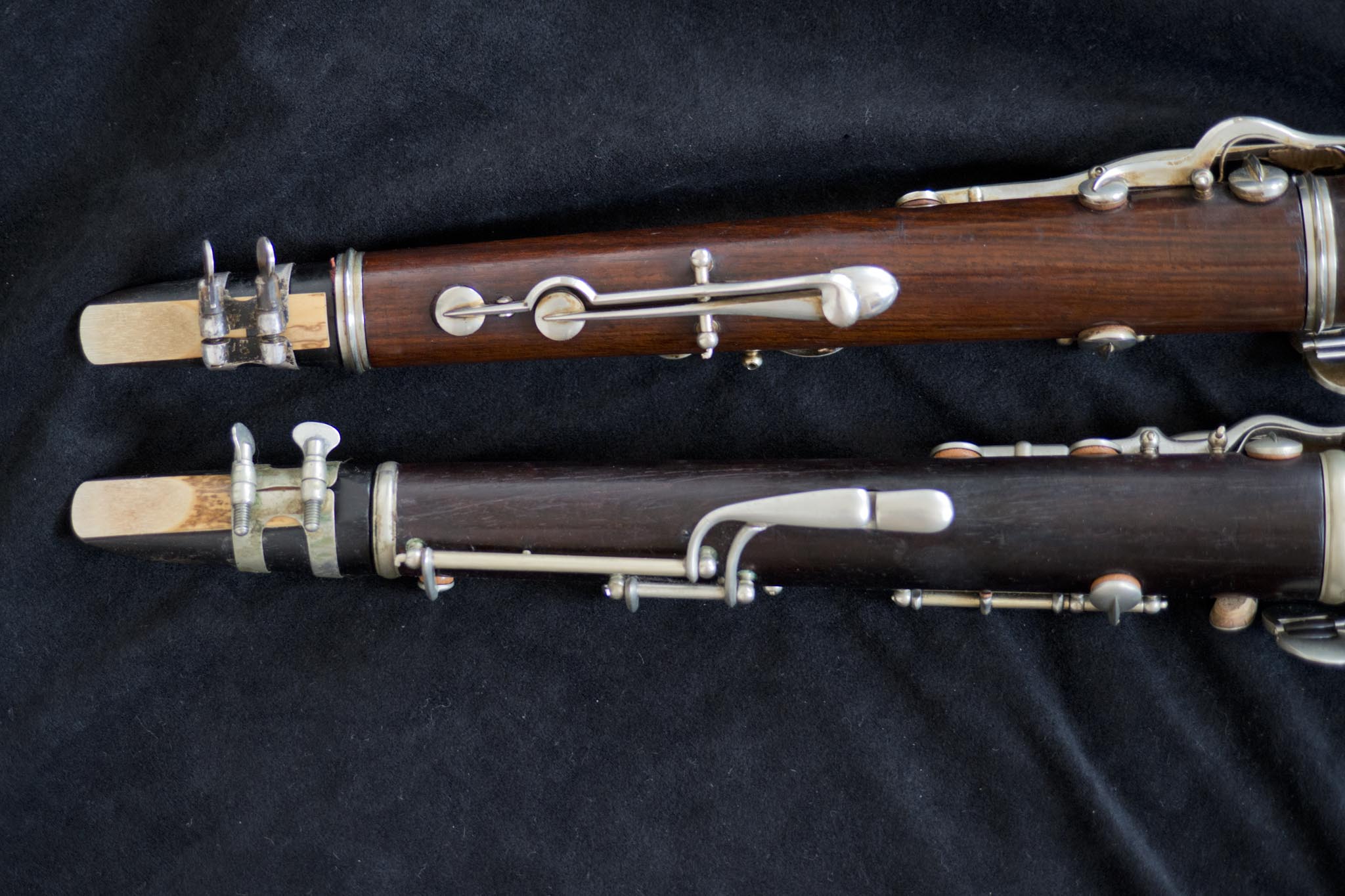
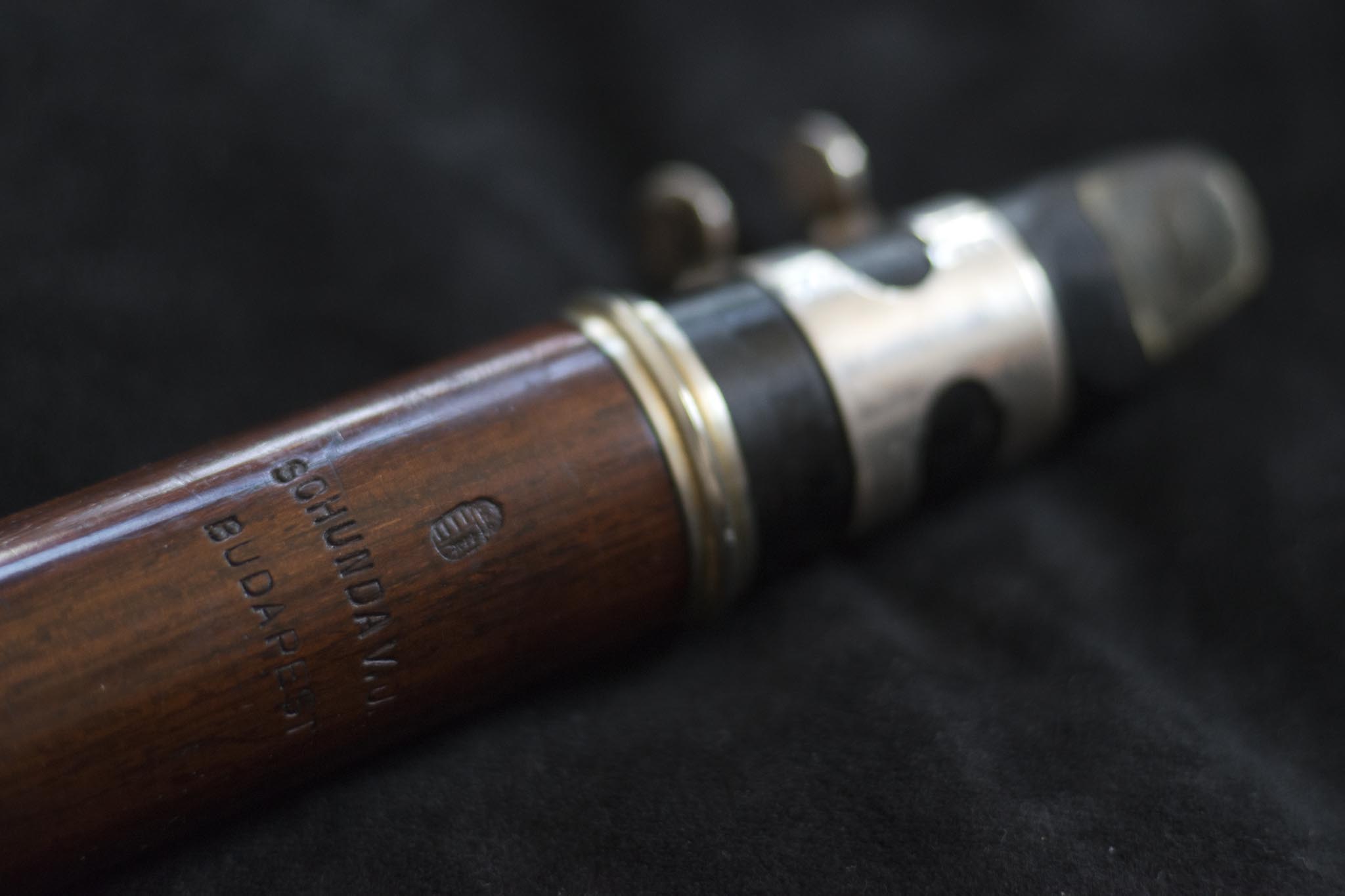


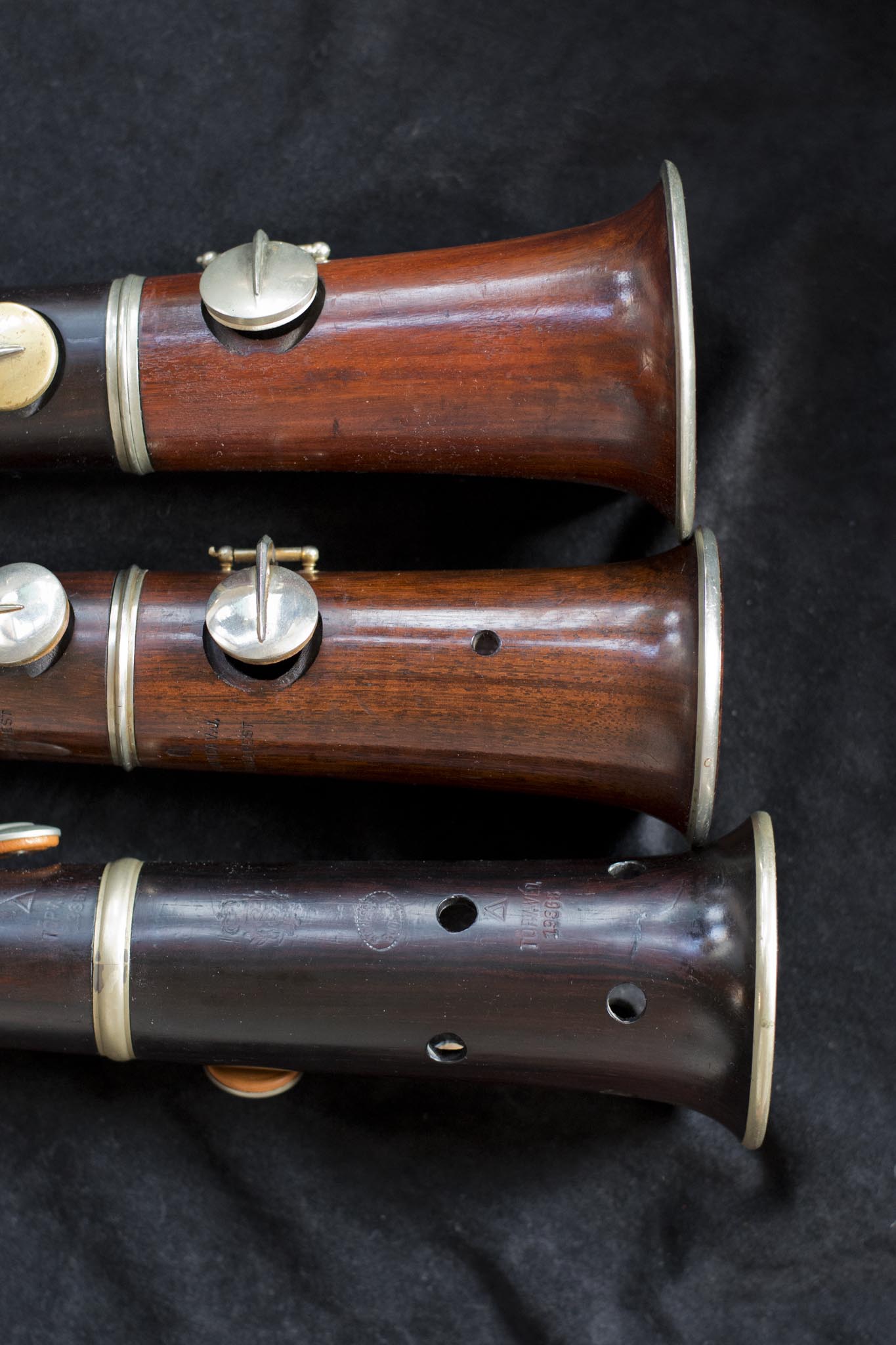
2013/07/28 @ 08:21
Hello Toby,
What a story! It reeds like a Scandinavian thriller. And then the illustrations. It is really wonderful.
My site is obsolete now. You have gone into one of the most interesting tarogato questions. It is even said that Janosz Stowasser was a Schunda employee.
Keep up the good work!
Henk
2013/08/02 @ 18:01
I have an authentic Stowasser for sale, in mint condition, with fairly new cork and pads. No cracks. 10 resonator holes in the bell. Comes with a great Hans Gruber mouthpiece (specifically made for the tarogato). Case included. Definitely not a fake.
2013/08/11 @ 12:43
Hi Franklin–do you have any pictures? I have more Stowassers than I need now, but I know people who are always interested.
2013/11/15 @ 01:51
i am intrested to buy an stowasser tarogato do you can help me…
2013/11/19 @ 02:26
I don’t know of any for sale now, but they do come up on eBay from time to time.
2016/02/19 @ 08:17
greeting given may know to whom I could sell clarinet janoš stovareš budapest? and how to send pictures to look at what it is and how much it’s worth?
2013/08/15 @ 04:24
Hello, I’m looking for a good original stowasser tarogato for a long time, can you please give me more details about the instrument and some pictures? Thank you!
George
2016/02/19 @ 08:18
how to send you a picture?
2013/09/07 @ 07:55
I am now looking for a stowwasser tarogato and would appreciate learning about any currently available. Thanks!
2013/09/07 @ 19:35
Art–write to Franklin directly at komponist53@gmail.com
2013/08/24 @ 05:58
Can you tell me of a source to find a quality mouthpiece? The instrument I just bought does not have one. I’m a professional jazz/doubler (clarinets, saxes, flutes) and I love this sound…I believe a great mouthpiece will make all the difference! Thanks for your site!
2013/10/01 @ 13:26
I make tarogato mouthpieces if you are interested .
2015/05/01 @ 01:25
Hello,
Can you let me know about your tarogato mouthpieces. i have an old Hungarian instrument that is tuned to high pitch, so I have to pull the mouthpiece almost off the cork to be in tune. It would be nice to have a longer mouthpiece to compensate.
2015/05/04 @ 01:31
Hi Cady,
Please write to Ioan at jstarogato@aol.com. I doubt that he reads this. Be aware that tarogatos, like saxophones, tune not so much by length of the mouthpiece, but by volume of the mouthpiece. In a sax, there is the possibility of pulling the mpc off the neck. It is not so much the extra length but the extra volume inside the mpc that makes the instrument flatter in pitch. So one possibility is to hollow out your mpc. However if you don’t know where to hollow it out, it can affect the playing. Are you sure your tarogato is in high pitch? Almost all the Hungarian tarogatok that I know of were tuned to A=440. When you pull your mpc almost off the cork, are all the notes more or less in tune. If your instrument is in high pitch, pulling the mpc off like that would tend to make the notes higher up the tube, like the B and C, quite flat compared to the D and Eb and E in the second octave. If the octave break is OK, your instrument is in low pitch and you just need a mpc with more volume. Ioan doesn’t speak too much English, but his wife helps him. Best might be to actually send him your instrument, and he will custom make a mouthpiece for you. I believe he charges about $300.
Best,
Toby
2013/10/01 @ 17:27
Steve, Ioan is a great player and his mouthpieces are excellent. He makes them to order and you have options for the baffle height and tip opening. I have one and it blows very free with a big sound.
2014/04/25 @ 16:49
Hello,
I also have a unique Stowasser tarogato. It is the littlest one from tarogatos family. Wonderful!
2014/04/29 @ 11:28
Hi Cristian, Do you have a picture of it?
2014/04/30 @ 13:45
Of course, I email you a few pictures of it, and also a few near the soprano Stowasser tarogato (most used).
2014/05/29 @ 02:50
Hello can you tell me were I can find à good used Tarogato stowasser, schunda or an other brand? And are there good bohmsystemtarogato’s? Thank you dirk
2014/05/29 @ 17:23
Hi Dirk,
I haven’t seen any for sale lately. I will email you if I see anything for sale.
2014/05/29 @ 17:29
There are Boehm tarogatos available here:
http://tarogato.net/boehm.html
The new Stowasser company also makes what they call a Boehm tarogato, but it is a hybrid system
http://www.tarogato.hu/
2015/08/08 @ 20:29
Hello,
I have a great schunda Budapesta tarogato for sale. If you are întețește please write to me.
Regards,
George
2015/08/11 @ 06:59
Hello,
I have a great schunda Budapesta tarogato for sale. If you are intetested please write to me.
Regards,
George
2014/10/17 @ 22:09
Hello Toby, Great story about your search for the Schunda. October the 4th I attended a concert by Gerrit Boeschoten, Tarogato and Istvan Hajdu, piano. It was a wonderful concert, and afterwards Gerrit let me play his Stowasser and I managed to play it more or less. (I’m a clarinet/saxophone player myself) So now I’m hooked to the Tarogato sound and looking for a good one for sale, but first I want to learn more about the instrument, and found your website with very interesting information. Thanks! By the way are you familiair with the Hammerschmidt Tarogatok? All the best from Aad
2014/10/18 @ 19:35
Hi Aad,
Thanks! Interesting that you mention Hammerschmidt tárogatók. I actually just bought one! It is being shipped now. The quality appears very good–I’ll let you know more after I play it. I love these instruments, but you really need a decent one.
Best,
Toby
2021/02/05 @ 00:52
Hi Aad,
I have one Hammerschmidt tarogato, and it is very nice indeed. In some ways I prefer it to the Stowasser. It is a bit more Germanic somehow, a little more like the clarinet and less like the sax–more contained, but very precise intonation, especially in the second octave. There are, I believe a couple of different Hammerschmidt tarogatos, made by both father and son. Mine seems to be an older one.
2015/07/16 @ 19:14
Hello.
Hello.
I will sell a boxwood Tarogato. I can read: “Schunda VJ” “Budapest”. No Cracks. Without one ring. Keys in good shape, and wiht mouthpiece. I can send photos. My e-mail is:
arrozconchoco@yahoo.es
Could you tell me an assessment? Could you estimate the price?
Thanks.
2015/08/06 @ 15:17
Hi Ricardo,
This certainly appears to be an authentic Schunda instrument. They are quite rare. I am not an expert, and I can only say that the price would vary according to whether you find someone who is a collector. I’d say something around $2000 might be a minimum.
2016/02/19 @ 08:01
sale clarinet whether you know a site where I could put ads and images? and how to put pictures on this site that someone tells me how much it is worth approximately?
2016/02/20 @ 21:13
Hi Sandra,
I don’t know much about clarinets. There are some experts here:
http://www.woodwindforum.com/forums/
If you register there, you can post pictures and ask about the value. There is also a “for sale” area.
Another is here:
http://test.woodwind.org/clarinet/BBoard/list.html?f=1
Finally there is here:
http://www.saxontheweb.net/
After you register, you can go to “SOTW Forum” and look for a forum called “Doubling”. There is a clarinet area there where you can ask for information on your clarinet.
There is also a “For Sale” area there, where you can advertise to sell your instrument. Good luck!
Toby
2016/04/15 @ 22:01
Hello Again Toby.
Finally I’m selling my original Schunda Tarogato
http://www.ebay.co.uk/itm/351708196545?ssPageName=STRK:MESELX:IT&_trksid=p3984.m1555.l2649
Please share it.
Thanks.
2019/01/21 @ 02:24
Hello everyone! This is Ioan Scaunas. I am still making custom Tarogato mouthpieces and tuning adjustments. Please reach out to me if you have any questions! jstarogato@aol.com
2019/01/21 @ 02:37
Hello everyone! This is Ioan Scaunas. I am still making custom Tarogato mouthpieces and tuning adjustments. Please reach out to me if you have any questions. jstarogato@aol.com
2019/01/22 @ 08:56
I have several of Ioan’s mouthpieces and can highly recommend them. On tarogato it is very important to have the correct mpc dimensions and Ioan can adjust them to match your instrument for best tuning and response.
2021/06/27 @ 05:11
Hi! I am from Hungary.
I have a 120 years old, original Stowasser tarogato. It was my grandfather. I would like to offer for sale. It is from the early Stowasser series, more specifically a product from the first patent (11545 PATENT). It is pretty hard to find an instrument in such a great condition nowadays. It is restorated by the master János Gruber. It was already in a good condition, I have pictures that were taken before the restoration, you can compare the before and after easily. The case is also in proper trim, it is 120 years old as well, made from cowhide that is untouched to this day. I’m looking for the instrument’s new owner who could take it with competence, love and passion.
Thanks,
Zsanett
kismaszatka2308@gmail.com